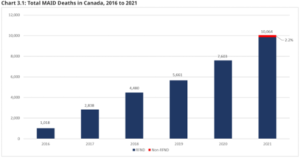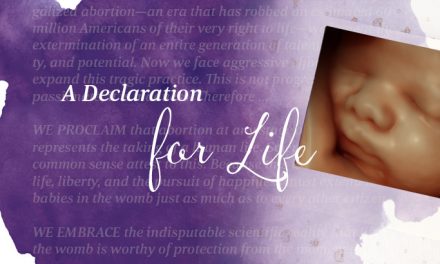Alan Nichols was checked into a Canadian hospital over fears he might be suicidal. He had no life-threatening medical conditions. He wasn’t taking his needed medications. And he wasn’t using his cochlear implant.
Then hospital staff improperly helped him in his request to die.
On his application for euthanasia, Nichols listed one singular disability: hearing loss.
He was promptly (and legally) killed by “doctors” in Canada.
For hearing loss.
Canada has one of the world’s most permissive euthanasia laws, as this story demonstrates. And its yielded tragic results.
According to the nation’s Annual Report on Medical Assistance in Dying (MAID), thousands of Canadians have been intentionally killed each year since the Canadian Parliament legalized euthanasia in 2016.
Since then, the number of Canadians who are euthanized has increased every year, both in nominal numbers and as a percentage of overall deaths.

The 2021 MAID Annual Report found that there were 10,064 individuals killed through euthanasia that year, “accounting for 3.3% of all deaths in Canada.”
Perhaps even more shocking is why these individuals were killed.
Of the more than 10,000 deaths, 17.3% (1,741 individuals) were killed because of “isolation or loneliness.”
That’s right.
Canadians are being killed because they are lonely.
Since Canada legalized euthanasia just six years ago, 31,664 Canadians have been legally killed, and the number rises every year.
The 2021 MAID Annual Report noted that the number of cases of individuals being killed through euthanasia in 2021 “represents a growth rate of 32.4% over 2020. All provinces continue to experience a steady year over year growth,” the report states.
The Canadian Minister of Health said that he was “proud” to present the annual report.
Under Canadian law, there are several requirements that are supposed to be met for an individuals’ request for euthanasia be approved.
These including the following:
- Request MAID voluntarily (self-request only).
- 18 years of age or older.
- Must provide informed consent.
- Diagnosed with a “grievous and irremediable medical condition,” where a person must meet all of the following criteria:
- Serious and incurable illness, disease or disability.
- Advanced state of irreversible decline in capability.
- Experiencing enduring physical or psychological suffering.
Though these guidelines have been enacted to place guardrails around Canada’s euthanasia regime, there are rising concerns that the nation’s foray into legalized murder has opened Pandora’s Box – and a wave of ethical and moral violations.
Returning to the case of Alan Nichols – killed because of hearing loss – did Nichols meet the requirements above?
Maybe. From a certain point of view. He did have a “disability,” after all.
But maybe not.
And that ambiguity is exactly the point.
When nations legalize euthanasia, they open the medical system up to all sorts of ethical and moral dilemmas. Relatively healthy individuals, who may just be lonely (or hard of hearing), are killed rather than thoughtfully treated and cared for.
Supporters of euthanasia usually sail under the banner of “compassion,” promoting their cause as “humane.”
But innocent human life always has value, and each person’s right to life should be respected.
Euthanasia isn’t compassionate. It’s assisted self-murder.
After Alan Nichols’ assisted suicide, his brother, Gary Nichols, gave The Associated Press his view of what happened to his brother: “Alan was basically put to death.”
“He needed some help from us, but he was not so disabled that he qualified for euthanasia,” said Gary Nichols.
But he was euthanized anyway.
The AP summarizes several of the problems with Canada’s euthanasia program:
- Medical authorities in Canada explicitly instruct doctors not to indicate on death certificates if people died from euthanasia.
- In other countries where euthanasia is legal, like Belgium, doctors are advised (or entirely forbidden) to avoid mentioning euthanasia to patients since it could be seen as a medical recommendation. But the Canadian association of health professionals encourages physicians to discuss euthanasia with their patients as one of their “clinical care options.”
- Canadian patients are not required to have exhausted all treatment alternatives before seeking euthanasia, as is the case in Belgium and the Netherlands.
Another case reported by The AP highlights the problems with doctors suggesting assisted suicide to their patients.
“Roger Foley, who has a degenerative brain disorder and is hospitalized in London, Ontario, was so alarmed by staffers mentioning euthanasia that he began secretly recording some of their conversations.
“In one recording obtained by The AP, the hospital’s director of ethics told Foley that for him to remain in the hospital, it would cost ‘north of $1,500 a day.’ Foley replied that mentioning fees felt like coercion and asked what plan there was for his long-term care.
“‘Roger, this is not my show,’ the ethicist responded. ‘My piece of this was to talk to you, (to see) if you had an interest in assisted dying.’”
As this story demonstrates, legalized euthanasia has transformed the doctor-patient relationship in Canada. Rather than seeing a patient’s infinite value as a human person, patients are monetized. They are seen as costing “the system” a certain number of dollars and cents.
And if that amount is too high, it is suggested to them that maybe their life isn’t worth the cost.
When medical students take the Hippocratic Oath, they promise to “do no harm.”
But euthanasia turns this on its head, transforming doctors and nurses from caring healers to cold dealers of death.
Even worse, Canada is set to liberalize its euthanasia laws even further next year, by permitting minors and individuals with mental health challenges to be killed.
In the 1930s, when the Nazi regime officially began their euthanasia program, the phrase “life unworthy of life” (In German: “Lebensunwertes Leben”) was used as a designation for those individuals who were determined not to have the right to live.
These individuals, who had serious medical problems or were determined to be of an “inferior race,” were euthanized.
The Nazi regime used propaganda and public posters to promote their extermination program. According to the United States Holocaust Memorial Museum, the Nazi regime “singled out people with intellectual and physical disabilities” for euthanasia.
In one poster, promoting their euthanasia program, the Nazi Party’s Race Office shared a picture of a disabled individual with the following text: “This hereditarily ill person will cost our national community 60,000 Reichmarks over the course of his lifetime. Citizen, this is your money.”
Can you see the same logic at play in the case of Roger Foley?
With the same logic, the Canadian medical community is facilitating the euthanasia of its patients. In the 21st century.
That is a great moral evil, and a terrible tragedy.
It’s past time Canada turn away from its Hitlerian experimentation with euthanasia and restore the right to life that is inherent to every human person.
Related articles and resources:
Answers to Common Questions About Physician-Assisted Suicide
New Mexico Becomes Ninth State to Pass Physician-Assisted Suicide; What Christians Need to Know
Canada Likely to Approve Assisted Suicide for Mentally Ill
Euthanasia Out of Control in Canada, Doctors Raise Alarm
Photo from Shutterstock.






